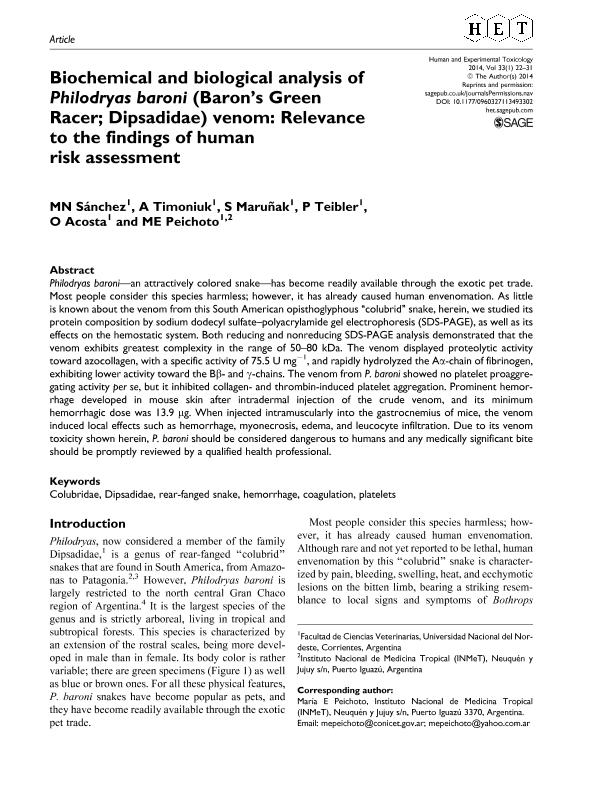Artículo
Biochemical and biological analysis of Philodryas baroni (Baron´s Green Racer; Dipsadidae) venom: relevance of the findings to human risk assessment
Sanchez, Matias Nicolas ; Timoniuk, A.; Maruñak, S.; Teibler, P.; Acosta, Ofelia Cristina
; Timoniuk, A.; Maruñak, S.; Teibler, P.; Acosta, Ofelia Cristina ; Peichoto, María Elisa
; Peichoto, María Elisa
 ; Timoniuk, A.; Maruñak, S.; Teibler, P.; Acosta, Ofelia Cristina
; Timoniuk, A.; Maruñak, S.; Teibler, P.; Acosta, Ofelia Cristina ; Peichoto, María Elisa
; Peichoto, María Elisa
Fecha de publicación:
06/2013
Editorial:
Sage Publications Ltd
Revista:
Human And Experimental Toxicoloxy
ISSN:
1477-0903
e-ISSN:
0960-3271
Idioma:
Inglés
Tipo de recurso:
Artículo publicado
Clasificación temática:
Resumen
Philodryas baroni - an attractively colored snake - has become readily available through the exotic pet trade. Most people consider this species harmless; however, it has already caused human envenomation. As little is known about the venom from this South-American opisthoglyphous "colubrid" snake, herein, we studied its protein composition by SDS-PAGE, as well as its effects on the hemostatic system. Both reducing and nonreducing SDS-PAGE analysis demonstrated that the venom exhibits greatest complexity in the range of 50-80 kDa. The venom displayed proteolytic activity towards azocollagen, with a specific activity of 75.5 U/ mg, and rapidly hydrolyzed the Aa-chain of fibrinogen, exhibiting lower activity towards the Bb- and g-chains. Philodryas baroni venom showed no platelet pro-aggregating activity per se, but it inhibited collagen- and thrombin-induced platelet aggregation. Prominent hemorrhage developed in mouse skin after intradermal injection of the crude venom, and its minimum hemorrhagic dose was 13.9 mg. When injected intramuscularly into the gastrocnemius of mice, the venom induced local effects such as hemorrhage, myonecrosis, edema and leucocyte infiltration. Due to its venom toxicity shown herein, P. baroni should be considered dangerous to humans and any medically significant bite should be promptly reviewed by a qualified health professional.
Palabras clave:
Colubridae
,
Rear-Fanged Snake
,
Hemorrhage
,
Coagulation
,
Platelets
,
Dipsadidae
Archivos asociados
Licencia
Identificadores
Colecciones
Articulos(CCT - NORDESTE)
Articulos de CTRO.CIENTIFICO TECNOL.CONICET - NORDESTE
Articulos de CTRO.CIENTIFICO TECNOL.CONICET - NORDESTE
Citación
Sanchez, Matias Nicolas; Timoniuk, A.; Maruñak, S.; Teibler, P.; Acosta, Ofelia Cristina; et al.; Biochemical and biological analysis of Philodryas baroni (Baron´s Green Racer; Dipsadidae) venom: relevance of the findings to human risk assessment; Sage Publications Ltd; Human And Experimental Toxicoloxy; 33; 1; 6-2013; 22-31
Compartir
Altmétricas



